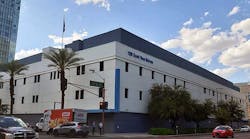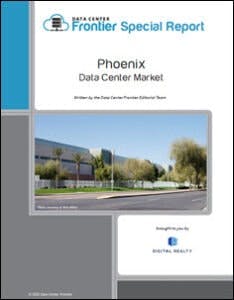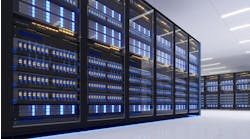Why Phoenix is an Increasingly Hot Data Center Market
The Phoenix data center market is one of the most dynamic in the U.S. and is among the top five in terms of capacity. This launches our special report series on the Phoenix Data Center Market.
Get the full report.
Phoenix continues to be one of the most dynamic data center growth markets in the U.S. Users have long sought space in Phoenix as an alternative to California locations with higher cost and disaster risk.
Phoenix has now become a data center destination in its own right, attracting a larger concentration of both customers and service providers in the process. It is positioned for additional growth as customers continue to seek alternatives to California due to recent changes in its risk profile.
The Phoenix market is home to 2.6 million square feet (SF) of commissioned data center space, representing 458 megawatts (MW) of commissioned power at the end of the first quarter of 2022, according to market research from datacenterHawk. These metrics place Phoenix as a top five market for data center capacity in the U.S., joining Northern Virginia, Silicon Valley, Dallas and Chicago.
Over the past year, Phoenix was one of the most active markets globally in terms of hyperscale demand and development. Data center operators that anticipated this growth and chose to develop campuses in the region are capitalizing on hyperscale activity in the market. The growth rate in Phoenix is dramatic.
This year we expect to see continued growth in Phoenix, as power availability and real estate challenges in California push large data center users further east.
An Overview of an Increasingly Hot Market: Phoenix
While some Phoenix businesses experienced challenges over the past 10 years, data centers have been a success story in the market. Data center users and operators have been extremely active in Phoenix recently, spurring an increase in supply to meet the demand from users both in and out of the market. As Phoenix’s business climate improved, opportunities and growth were created for data center users and operators from across the United States. Phoenix attracts data center users for the following reasons:
- Low Natural Disaster Risk — The city has almost no history of damage associated with seismic, tornado, and flooding events
- Inexpensive Power Cost — A diverse fuel mix and competition from several power providers create a reliable and competitive power environment
- Tax Abatement Opportunities — Legislation passed in 2013 enhances the state’s ability to compete on large, national data center requirements
- Competitive Colocation/Cloud Environment — Quality colocation and cloud providers have invested significantly in Phoenix over the past few years, creating a competitive market for data center users
As Lee McPheters, research professor of economics at Arizona State University noted in his 2020 economic outlook for Arizona, the state has rebounded to pre-2007 conditions, employing 2.93 million people, with over 80,000 new jobs created in 2019. That’s the highest employment Arizona has seen since October 2007. Phoenix is the primary contributing factor to Arizona’s economic growth, with 92% of new Arizona jobs coming from Phoenix. As such, the Phoenix data center market has seen similar growth in the last several years, growing by over 225 MW of commissioned power since 2015.
From a geographic perspective, data center capacity in Phoenix area has become distributed across the city and a number of sub-markets in suburbs. Most of the colocation data center providers are located in Phoenix proper and Chandler, a city approximately 25 miles to the southeast of downtown Phoenix.
There have been several developments in Chandler, including data center projects from Digital Realty, CyrusOne and H5, and the groundbreaking of Intel’s $20B expansion in Arizona.
In recent years we have seen the emergence of Mesa and Goodyear as notable emerging markets. These will be discussed in more detail in a future article in this series.
A combination of lower electricity prices and real estate costs have lured data center providers to create facilities designed to meet the needs of large users. Digital Realty’s 120 East Van Buren is the prime carrier hotel in the downtown Phoenix market. Several other providers, including Iron Mountain, Cyxtera, and PhoenixNAP are located east of downtown Phoenix, near Phoenix Sky Harbor International Airport. In addition, other areas including Tempe, Scottsdale, and Deer Valley have several data center providers.
These market attributes enable Phoenix to compete for many small and large data center users as a possible location. This is particularly true for hyperscale deployments, with other companies consistently searching the Phoenix market include those in the e-commerce, financial, insurance, healthcare, and technology industries.
Key Phoenix Market Updates
In 2Q 2021, the proposal of a Facebook data center in Mesa created a surge of local apprehension regarding water usage. Subsequent to the deliberation and ultimate approval of the project, municipal governments in several Phoenix suburbs, including Chandler and Avondale, have echoed concerns regarding data center development. Most hesitancies are around the lack of available water needed to cool data storage facilities, although scarcity of land, noise complaints, and the minimal production of jobs are becoming increasingly unsettling to communities in Phoenix.
Digital Realty has contracted with SRP to provide solar power equivalent to 19% of its usage at its Chandler facility.
Data center developers have taken steps to address community concerns with initiatives to preserve and replenish local water resources. In announcing its Mesa development, Meta partnered with local environmental groups to restore 200M gallons of water sourced by the Colorado River and Salt River Basin. In announcing its project in Goodyear, Microsoft said it would work with Gila River Storage to replenish local aquifers, as well as a program with the state to sustain water levels in Lake Mead.
The industry also continues to advance sustainability by provisioning solar energy to reduce its climate impact. Meta has partnered with utility Salt River Project (SRP) to provide 450 MW of solar, while Digital Realty has contracted with SRP to provide solar power equivalent to 19% of its usage at its Chandler facility.
The growing public uncertainty regarding data centers could make zoning approval a larger obstacle in the future. As an example, projects in Chandler have recently met community resistance, and last year the city council said it would review limits on data center development.
Download the full report, Phoenix Data Center Market, courtesy of Digital Realty, to learn more about this competitive data center market. In our next article, we’ll look at trends in data center demand.






